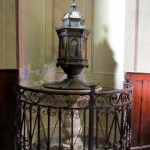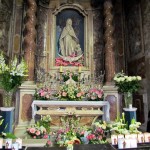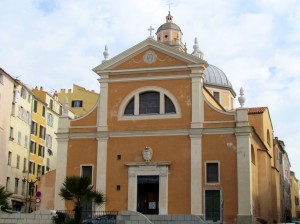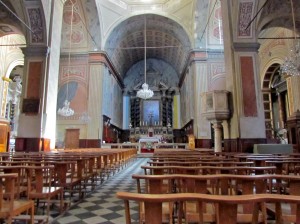Ajaccio’s cathedral, dedicated to the Virgin Mary and built in 1593, is steps from the Bonaparte house. Tradition says it was here on August 15, 1769, Letizia Bonaparte felt sudden labor pains and rushed home, giving birth to Napoleon on a first floor sofa before she could reach her upstairs bedroom. The church hasn’t changed much, except back then it reputedly smelled dreadful, due to the local custom of burying the untreated dead beneath its floor—combined with the stench of butcher shops just outside its doors. Thankfully, the bodies have been removed and, although there’s still a butcher shop nearby, it’s pristine.
 A sign over the baptismal font claims Napoleon Bonaparte and his little sister were baptized here in 1771. Like many Napoleonic legends, that may not be true, as other evidence says he was a sickly infant so, as a precaution, his uncle the Archdeacon baptized him at home shortly after his birth. I’m not sure either baptism took: Napoleon, although not an atheist, had little respect for organized religion.
A sign over the baptismal font claims Napoleon Bonaparte and his little sister were baptized here in 1771. Like many Napoleonic legends, that may not be true, as other evidence says he was a sickly infant so, as a precaution, his uncle the Archdeacon baptized him at home shortly after his birth. I’m not sure either baptism took: Napoleon, although not an atheist, had little respect for organized religion.
 This church reminds me poignantly of the one my Catholic family attended in the south of France when I was a young girl. It has the same wooden chairs, worn cold stone floors, and saints staring down from side chapels. The shadows exude sacred intimacy and immortal authenticity. Although Napoleon’s cathedral no longer smells of the dead, the scent of its burning candles, always a lure to me as a child, rekindles memories of beliefs I lost long ago.
This church reminds me poignantly of the one my Catholic family attended in the south of France when I was a young girl. It has the same wooden chairs, worn cold stone floors, and saints staring down from side chapels. The shadows exude sacred intimacy and immortal authenticity. Although Napoleon’s cathedral no longer smells of the dead, the scent of its burning candles, always a lure to me as a child, rekindles memories of beliefs I lost long ago.



Pingback: Finding Napoleon: Propaganda from a Plague - Margaret Rodenberg